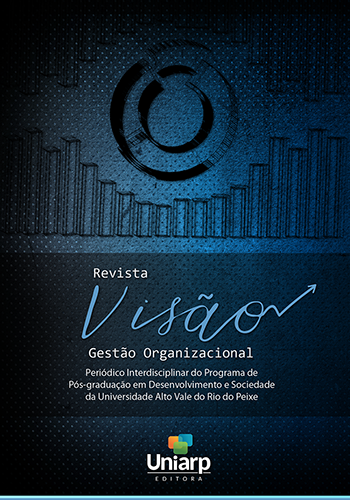Employability from workers' view in pandemic times
EMPLOYABILITY FROM WORKERS' VIEW IN PANDEMIC TIMES
DOI:
https://doi.org/10.33362/visao.v10i2.2453Keywords:
Mercado de Trabalho, Inserção Profissional, Situação Profissional, Empregabilidade, COVID19Abstract
The aim of this study was to analyze the employment situation of workers in times of pandemic COVID19. The research is quantitative and the type was survey and descriptive. The sampling was non-probabilistic and for convenience, obtaining 115 participants, but 92 valid. Data obtained through a structured questionnaire using google forms. Distributed on social networks, by the snowball method, statistically analyzed using the SPSS 22 software. The analysis was divided into 4 parts, where the first dealt with the respondent's Socioeconomic profile, the second with the insertion and professional situation of workers, the third with perceptions about the organization, insertion in the labor market and employability, and the last and fourth part of the perceptions about changes in work routine from the COVID event19. It was observed as to the respondents' profile: most were women (69.6%). The age range of the sample was balanced between 18 to 25 years (30.4%), 26 to 37 years (35.9%) and 38 to 51 years (30.4%). As for education, 71.8% have higher education or more. 66.3% are married or in a stable relationship. Of these, 66.3% have their own housing. 83.7% are working. As for the professional and employability situation of workers, it can be seen that this portion of the population has remained stable in their jobs and professional situation. 78% are satisfied with their current job and 80.4% remain working at the same company, against 11.9% of unemployed at the time of data collection. A certain balance was observed in the sampling, around 30% of micro and large companies, from all branches, with a predominance of services, with 30.4%, 62% of respondents working in private organizations. Regarding the perception of work changes with the pandemic event, from the analysis it can be seen that most believe they have autonomy to carry out their activities (59.8%), work in organizations that have some career progression system (46.7%), are the main responsible for their employability and training (46.7%). As for the position, 44.5% say they occupy a job vacancy below their level of qualification, however 45.7% say that the remuneration is adequate to qualification and this, in turn, is necessary for the activity (35.9%). It was noted that 45.6% of respondents do not agree with the fact that higher education has influenced their career progression in the company, however some are not sure about this (28.3%), while 26.1% partially or totally agree with training is an important career requirement. Respondents also do not recognize the network network (54.4%) and intermediary agencies (41.3%) as facilitators in the process and insertion and professional situation. It was concluded with the study that the majority of the respondents are stable in their jobs, satisfied, considering that the sample points to people of so-called “middle class” where the majority have higher education or more and occupy positions according to the training. It is inferred that perhaps this is not the reality of the population, having seen the Brazilian data on precariousness and unemployment.
References
BALDIN, Nelma; MUNHOZ, Elzira M.Bagatin. Snowball (bola de neve): Uma técnica Metodológica para pesquisa em educação ambiental comunitária. Fundo de Apoio à Pesquisa – FAP – Univille. 2011. P. 332.
CABRAL, Tiago. Como está o mercado de trabalho com a pandemia de Covid-19? Idados.id, 05 jun, 2020. Disponível em < https://idados.id/blog/mercado-de-trabalho-com-a-pandemia-de-covid>19 acessado em agosto 2020.
CRESWELL. J. W. Projeto de Pesquisa: Métodos Qualitativo, Quantitativo e Misto. Porto Alegre/RS: Grupo A, 2010. 9788536323589. Disponível em: https://integrada.minhabiblioteca.com.br/#/books/9788536323589/. Acesso em: 19 Nov 2020
FIESC. Abertura de vagas no setor industrial. 26 ago. 2020. Disponível em: https://www.observatoriofiesc.com.br/post/segundo-semestre-inicia-com-abertura-de-vagas-no-setor-industrial>. Acessado em setembro de 2020.
GUEDES et al., Análise descritiva. 2005. Disponível em: http://www.each.usp.br/rvicente/Guedes_etal_Estatistica_Descritiva>.pdf acessado em novembro de 2020
INSTITUTO BRASILEIRO DE GEOGRAFIA E ESTATÍSTICA. IBGE. Pnad Contínua trimestral. Rio de Janeiro: IBGE, 2020. Disponível em: https://www.ibge.gov.br/estatisticas/sociais/trabalho/9173-pesquisa-nacional-por-amostra-de-domicilios-continua-trimestral.html?=&t=destaques. Acesso em: maio, 2020.
MATIAS-PEREIRA. Manual de Metodologia da Pesquisa Científica. Grupo GEN, 2016. 9788597008821. Disponível em: https://integrada.minhabiblioteca.com.br/#/books/9788597008821/. Acessado em: 31 Out 2020.
MARTINS, Marcos Madeira de Mattos. A empresa e o valor do trabalho humano. 2.ed. São Paulo: Almedina, 2015. P 19;
MELO, Paulo e Ciampa, Amábile de Lourdes. Marketing pessoal e empregabilidade: do planejamento de carreira ao networking. Ed. São Paulo. Érica, 2014.
MENDONÇA, Gustavo Henrique. Desemprego. Mundo Educação. Acessado em 17 de nov. 2020.
NASCIUTTI, Jacyara Carrijo Rochael. Pandemia e perspectivas no mundo do trabalho. Caderno de Administração. Publicado em 05 de jun. de 2020.
NAKABASHI, Luciano. Colunista fala sobre os efeitos da Crise no mercado de trabalho. Jornal da USP. Publicado em 10 de jun.2020.
OLIVEIRA, Ramon. Empregabilidade. Dicionário Educação da Profissional em Saúde 2009. Acessado em 25 de out. 2020.
PEREIRA, Mônica de Carvalho. Como anda o mercado de trabalho? Acessa.com mais comunicação. Disponível em <https://www.acessa.com/arquivo/galera/profissoes/1999/03/05-Coluna_Monica_03> Acessado em setembro de 2020.
PEREIRA, S. DE C et al. Trabalho de conclusão de curso (TCC): uma abordagem leve, divertida e prática. Editora Saraiva, 2019. p 153 e 155. Acessado em novembro, 2020.
PMC – Prefeitura Municipal de Caçador. Notícias. Disponível em < https://www.cacador.sc.gov.br >. Acessado em setembro de 2020.
ROCHA-DE-OLIVEIRA, Sidinei. Inserção Profissional: Perspectivas Teóricas e Agenda de Pesquisa. Revista Pensamento Contemporâneo em Administração. 2012, p. 4 e 7. Acessado em out. de 2020.
ROCHA DE OLIVEIRA, Sidinei; PICCININI, Valmiria Carolina. Mercado de trabalho: múltiplos (des)entendimentos. Revista de Administração Pública, Rio de Janeiro, v. 45, n. 5, p. 1517-1538, out. 2011. Disponível em <http://www.scielo.br/scielo> acessado em 18 nov. 2020.
ROCHA DE OLIVEIRA, Sidinei; PICCININI, Valmiria Carolina. Inserção Profissional: contribuições dos estudos franceses. Enanpad, 2008. Rio de Janeiro/RJ. Disponível em < http://www.anpad.org.br/diversos > acessado em outubro de 2020.
SANKHYA, Gestão de Negócios. Disponível em: <https://www.sankhya.com.br/blog/crise-economica> Acessado em setembro de 2020.
SANTOS, Vanessa Sardinha dos. “Corona vírus (COVID-19)”; Brasil Escola. Disponível em <https://brasilescola.uol.com.br/doencas/coronavirus-covid-19.htm > Acessado em 13 de setembro de 2020.
SILVA, Wellington Souza. Mercado de Trabalho. Info Escola. 2014. Disponível em: <https://www.infoescola.com/economia/mercado-de-trabalho/> acessado em setembro de 2020.
SINE. Notícias. Disponível em <https://www.cacador.net/noticias/geral/2020/05/13/ >acessado em: setembro de 2020.
VOLKMER MARTINS, Bibiana. Expansão e Diversificação do Ensino Superior no Brasil: a mobilidade social e a inserção profissional dos jovens estudantes e egressos de cursos superiores tecnológicos na região metropolitana de Porto Alegre - RS. 2016. 437f. Tese (Doutorado em Administração). Programa de Pós-graduação em Administração, Escola de Administração, Universidade Federal do Rio Grande do Sul. Porto Alegre.
Downloads
Published
How to Cite
Issue
Section
License
Copyright (c) 2021 Marlene Knecht Ramos, Geneia Lucas dos Santos

This work is licensed under a Creative Commons Attribution-NonCommercial 4.0 International License.
Estou ciente de que, através da submissão voluntária de meu texto ao corpo editorial da revista Visão, editada pela Universidade Alto Vale do Rio do Peixe - UNIARP, estou concedendo à Universidade Alto Vale do Rio do Peixe a autorização de publicar o respectivo texto na revista a título não oneroso e declarando a originalidade do texto e sua não submissão simultanea a qualquer outro periódico, em meu nome e em nome dos demais coautores, se eventualmente existirem.Reitero que permaneço como legítimo titular de todos os direitos patrimoniais que me são inerentes na condição de autor. Comprometo-me também a não submeter este mesmo texto a qualquer outro periódico no prazo de, pelo menos, um (1) ano. Declaro estar ciente de que a não observância deste compromisso acarretará em infração e conseqüente punição tal como prevista na Lei de Proteção de Direitos Autorias (Nº9609, de 19/02/98).














 Revista Visão: Gestão Organizacional está licenciado com uma Licença
Revista Visão: Gestão Organizacional está licenciado com uma Licença 